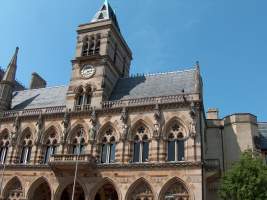
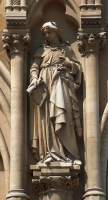
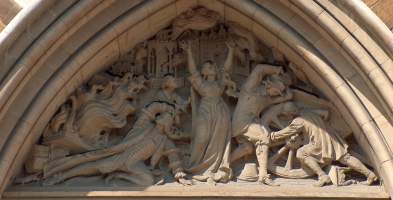
Godwin's Town Hall, a sample figure (Mercy) by Boulton, and a panel by Nichols.
Northampton, an hour and a half away from London out of Euston station, is not a particular destination to see Victorian art, but in the rather battered town centre there are two good things - the Museum and Art Gallery, and the Guildhall, which serves as a municipal building for the local authority.
The Museum is in large part devoted to shoes, the making of which was the main claim to fame of the town, apart from a role in the life and defeat of Charles I. Plenty of 19th Century shoes for anyone remotely interested. From the perspective of these pages, we may note an occasional picture of shoemakers by 19th Century artists, works by John Collier, including a portrait of Charles Bradlaugh, a local cause celebre who was elected as an MP, but as an avowed athiest, was unable or unwilling to swear the oath of allegiance on the Bible. A statue of him is noted further down this page, and a couple of portraits by G. F. Watts, of members of the Cavendish-Bentinck family. Upstairs, in the surprising collection of Italian paintings, mainly of the Venetian School, is a full size bronze statue of Thyrsis playing the flute by J. Havard Thomas (1854-1921).
The remainder of the collections include decent material on the history of the town, and a ceramics collection with a few bits of William de Morgan pottery and Martinware (given by Mrs Hull Grundy), other studio pottery, and art nouveau work.
Godwin's Town Hall, a sample figure (Mercy) by Boulton, and a panel by Nichols.


The Gothic Town Hall (guildhall) was originally erected in 1861-64 by the architect E. W. Godwin, but then extended in similar style two decades on by local architect Matthew Holding, (interiors by A. W. Jeffery). The result is pleasingly asymmetric about the squat tower. The whole frontage is encrusted with sculpture - a series of 14 statues at first floor level by R. Boulton, apparently, and half-roundels showing Northampton life at the tops of the Gothic arches of the ground floor windows, by T. Nicholls - presumably the Thomas Nicholls who worked for the architect William Burges. The statues, in stone, include a variety of kings, queens, saints and others, with some link to the area. Some of the scenes below are most lively, with battles and fires. As well, a wide variety of gargoyle heads, little beasts and floral execrences adorn the surface of the building. Inside, murals of the early 20th Century by Colin Gill, and stained glass panels, though when I visited it was not possible to see these. However, in the side entrance to the Registrar, can be seen a fine statue by Chantrey of Spencer Perceval. Much more detail on Northampton Guildhall on this page.
We should mention in passing a couple of other sculptural efforts in the town. East of the centre, on Abington Street, is a monument in terracotta by Tinworth of Charles Bradlaugh, though the statue is painted so could as well be stone - perhaps this was the intention. By it, a stone obelisk with portrait bust in bronze to Edgar Mobbs, founder of 'Mobbs Company', a war and a rugby scene on either side, and on top, Victory as a young girl - decent work of WW1 vintage.
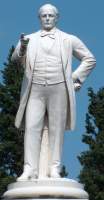
 Charles Bradlaugh, and the curvily posed summit figure on the Mobbs memorial.
Charles Bradlaugh, and the curvily posed summit figure on the Mobbs memorial.
Off Abington Street, on an alley crossing The Riding, is the building of Malcolm Ingles and Company, of Glasgow, with two portraits of bulls, a concave dome above the door in arts and crafts style with the motto 'Let Glasgow flourish', and in the spandrels above, a pair of reclining girls, all rather worn. And in Abington Street itself, the Public Library, by H. Norman, 1910, with statues of Dryden and Fuller, and two portraits, including one of Washington, a wool merchant who numbered the eponymous United States President among his descendants. Towards the edge of town, by the hospital, is a rather excellent Edward VII Memorial by George Frampton.
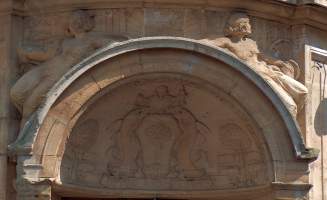 Malcolm Ingles building, nouveau girls.
Malcolm Ingles building, nouveau girls.
The town centre includes four good churches, of which the Parish Church, All Saints, and the Norman St Peter's Church, which is covered on this page, are generally open.
Half a mile's walk out of Northampton is Hardingstone, and along the way stands one of the three surviving Eleanor Crosses with interesting medieval sculpture (see this page), and further away but still in Northamptonshire is Geddington, where the second surviving Cross is (see this page for Eleanor Crosses).
Northampton Guildhall // Northampton's Edward VII Memorial // Sculpture pages // Statues in English towns
Visits to this page from 23 Nov 2011: 8,428